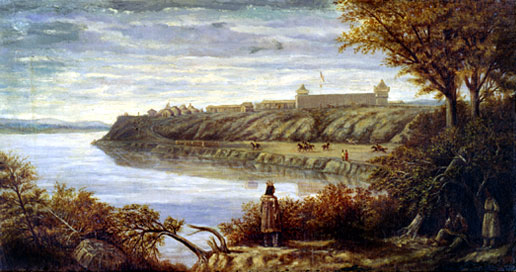We’ve launched a new web portal! Visit findhistory.nd.gov to search our collections.
Due to a road closure, the Killdeer Mountain Battlefield State Historic Site is temporarily closed.

It is difficult to overstate the long-term ramifications of the Expedition.
The most noticeable immediate effect was the rise in the northern plains
fur trade between 1806 and 1812. During that period individuals like Manuel
Lisa and John Colter–the latter a member of the Corps of Discovery–established
short-lived trade from northern South Dakota to Montana. After the War
of 1812, the trade was renewed with the advent of the Mountain Man
period (1820- 1845), during which time additional posts were erected in
the region. Ft.
Union was perhaps the flagship of these interests, particularly for
its owners, the American Fur Company of St. Louis.
Artists quickly followed in the wake of the Expedition, with individuals
such as Charles St. Memin, Paul Kane, George Catlin, and Karl Bodmer presenting
to the world startling images of life on the Northern Plains. These helped
to further popularize the west in the popular imagination and would help
fuel immigration in the decades to come.
For Native Peoples, the aftermath of the Lewis and Clark was anything
but a positive experience. Perhaps the most devastating was the outbreak
of smallpox among the Mandan in 1837, an epidemic which all but destroyed the once-powerful
group. This catastrophe was a major impetus in further uniting the surviving
Mandan and Hidatsa, whom the Arikara joined at Like-A-Fish-Hook
village. There the Three
Affiliated Tribes engaged in trade, farming, and hunting. Worst of
all, during the last quarter of the 19th century, the reservation system
was instituted, taking away from the original inhabitants the vast majority
of their land. On reservations like Ft. Berthold, residents were forced
to convert to Christianity, take up farming in place of hunting, and educate
their children in white boarding schools. This terrible pattern was repeated
across the trans-Mississippi west and took a devastating toll on all tribes
involved.
The military also made its presence known by the mid-to late-19th century,
eventually building a series of forts across North Dakota in an effort
to protect settlers and railroad workers. Ft. McKeen, Ft. Abraham Lincoln,
Ft. Rice, Ft. Yates, Ft. Totten, Ft. Abercrombie, Ft. Buford, Ft. Berthold,
and Ft. Pembina were among the most notable of these military posts. Some
of these forts were the site of later historic events, such as Chief Joseph
and Sitting Bull’s giving up their struggle against white incursion
on their lands and forced culture change.
Economic, political, military, and social forces brought to bear as a
result of the expedition forever changed the northern plains that the
Native Peoples had known, and would also forever change those who came
to the prairie.
Address:
612 East Boulevard Ave.
Bismarck, North Dakota 58505
Get Directions
Hours:
State Museum and Store: 8 a.m. - 5 p.m. M-F; Sat. & Sun. 10 a.m. - 5 p.m.
We are closed New Year's Day, Easter, Thanksgiving Day, and Christmas Day. We are closed at noon Christmas Eve if it falls on Mon.-Thurs. and are closed all day if it falls on Fri.-Sun.
State Archives: 8 a.m. - 4:30 p.m. M-F, except state holidays; 2nd Sat. of each month, 10 a.m. - 4:30 p.m. Appointments are recommended. To schedule an appointment, please contact us at 701.328.2091 or archives@nd.gov.
State Historical Society offices: 8 a.m. - 5 p.m. M-F, except state holidays.
Contact Us:
phone: 701.328.2666
email: history@nd.gov
Social Media:
See all social media accounts